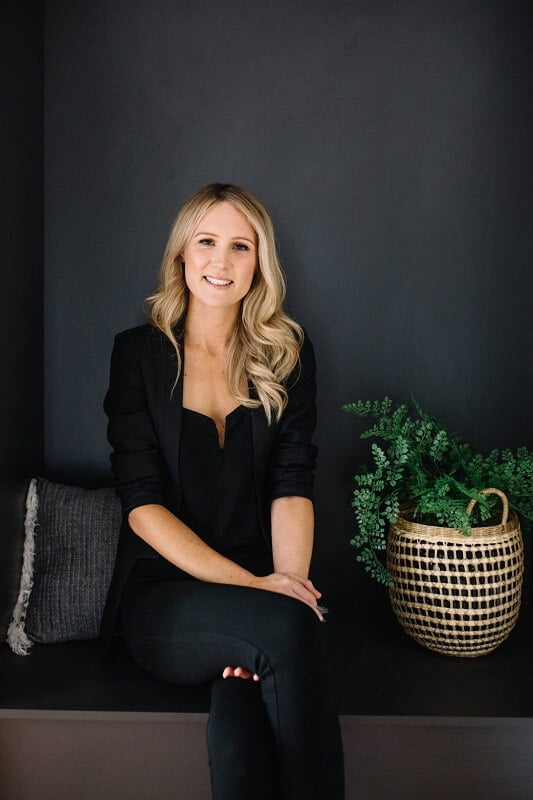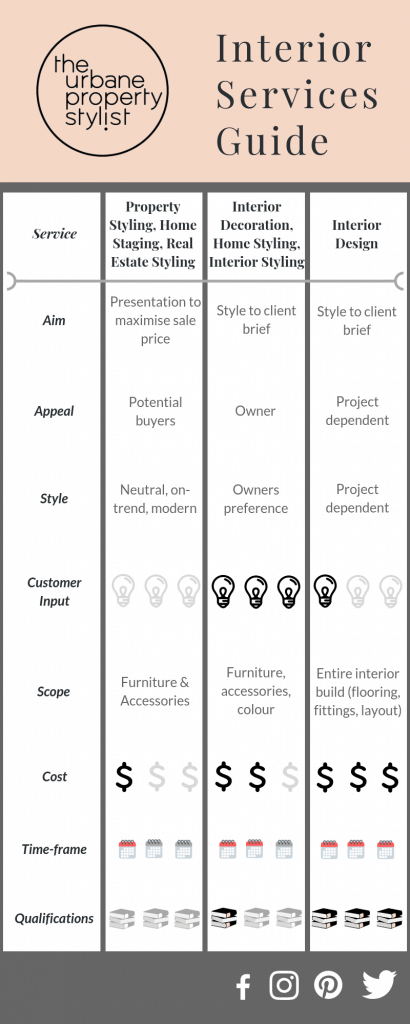Home staging, property styling, real estate styling. What’s the difference? Nothing, simple as that. These three terms all describe the same service. This got me thinking. There are many terms in the industry used to describe similar but different services. Interior design, interior decorating, home staging. Some of these are interchangeable, whilst others aren’t. For example, home staging and property styling are the same thing. Whereas interior design and interior decorating aren’t. I have written this article to assist you in differentiating interior services. I discuss scope, cost and time-frame of each. I hope that this information assists you in determining the service you need.
Home Staging, Property Styling, Real Estate Styling
These services cover the staging of a property in preparation for sale. The ultimate goal is to achieve the highest sale price. Demand drives sale price, and staging a property drives demand. Using on-trend, yet neutral styling attracts more potential buyers. Real estate styling, as the name suggests, is employed in the residential real estate market.
These services are best performed with little to no input from the client. The work of a real estate stylist should not be compromised with a client’s styling preferences. As you place trust in a real estate agent, you must also trust a stylist. Trust a real estate stylist to apply ideas and styling which will appeal to the target market.
Real estate styling is an investment. So, it must be cost effective. This is why, out of all interior services, it is the cheapest. Real estate styling remains affordable by limiting the design time-frame and customer input. Cost effective real estate styling ensures a return on investment for the client. An acceptable cost for home staging is relative to the value of the property.
Furniture, art, accessories and plants are the domain of home staging. Home stagers will not make permanent changes to a property. These are all temporary changes to the property. This is one reason why there are no qualifications required to become a property stylist. That being said, it is competitive industry. So, many property stylists, like myself, have obtained formal qualifications. Look for formal qualifications when selecting a property stylist. They’re a mark of knowledge and expertise.
Property styling is the most common term used to describe this service in Australia. Australians do use the term ‘home staging’, but it is less common. Throughout the rest of the world, particularly the UK and US, Home Staging is the most prevalent term. The fact that there is a home staging wikipedia page, and not one for property styling, supports this.
Home Styling, Interior Styling, Interior Decoration
These services provide styling to meet the personal preferences of the client. The service is often engaged on completed buildings and existing homes. Each service begins with an extensive client consultation. The stylist must understand and come to share the client’s vision. The goal is to coordinate interior elements and turn their vision into reality.
Unlike home staging, these services need extensive input from the client. Understanding the client vision is critical to achieving it. Thus, it is common for the stylist to return with digital concepts and ideas for client approval. The decorator will always deliver what the client wishes. They guide the client towards a greater outcome using their knowledge and qualifications. Unlike home staging, home styling includes more permanent changes. These include paint, flooring and material selection. The extra client interaction, and expansion to a wider scope, leads this to a costlier service. Furthermore, this requires an increased time-frame for client communications. Qualifications are not necessary within these services. Yet, utilising stylists/decorators with at least a diploma is recommended. This is due to the greater investment and permanency of the changes they make. Compared to home staging, formal qualifications are more common among these service providers.
Interior Design
Interior design holds the widest scope of all. It requires a holistic view. Adding function to form. How is a space best utilised? Their influence includes the entire layout of a room. This includes fixtures & fittings, lighting plans, colours, textures, flooring and material selection. For this reason, interior designers are often engaged before building has begun. Parallel to these elements, an interior designer will present their styling design. An interior designer will select furniture and accessories to deliver a coordinated product.
Aesthetics is the focus of the services discussed so far. Yet, interior designers take their influence a step further. They can drive significant functional changes. This includes moving or taking out walls and installing services. As such, interior designers also need knowledge of building codes and practices. Furthermore, interior designers present theory and research paired with their proposals. This supporting information, particularly for large residential developments, provides justification for their proposal. Interior designers often work with multi-disciplined teams in the construction process. They must master project management, communication and documentation standards. For these reasons, interior designers have bachelor’s degrees or advanced diplomas.
Interior design is the most expensive service covered here. This is due to the increased scope, time-frame and qualifications. Interior design services are best employed over medium to large developments. This can spread the cost, as done in residential developments. Working on a project for an entire year, the costs of an interior designer can extend into six figures. Yet, splitting this cost over dozens of apartments makes it an excellent investment. We recently styled one of these major developments for Mirvac Residential.
The Wrap
The similarity in naming of interior design services causes confusion. They can be grouped into three sets I’ve discussed. If you require an interior service, understand your needs and budget before searching for a service provider. The Urbane Property Stylist are property styling and home staging specialists. However, we also provide home styling services for select clients.

Emma Tobin, Director and Lead Stylist at The Urbane Property Stylist, holds a B.D. (Interior Design). With over ten years of experience in Interior Design, Landscape Architecture and Property Styling, Emma has earned a reputation for her attention to detail and ability to deliver.

